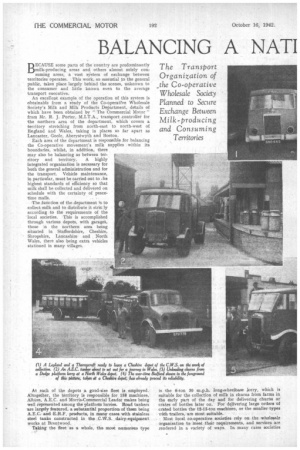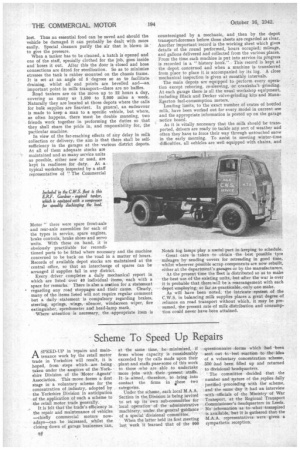BALANCING A NATI
Page 30

Page 31

Page 32

If you've noticed an error in this article please click here to report it so we can fix it.
-WIDE MILK SUPPLY
DECAUSE some parts of the country are predominantly
milk-producing areas and others almost solely con suming areas, a vast system of exchange between territhries operates. This work, so essential to the general public, takes place largely behind the scenes, unknown to the consumer and little known even to the average transport executive.
An excellent example of the operation of this system is obtainable from a study of the Co-operatrve Wholesale Society's Milk and Milk Products Department, details of which have been, obtained by "The Commercial Motor " from Mr. R. J. Porter, M.I.T.A., transport .controller for the northern area of the department, which covers a territory stretching from north-east to north-west of England and Wales, taking in places so far apart as Lancaster, Goole, Aberystwyth and Boston.
Each area of the department is responsible for balancing the Co-operative movement's milk supplies within its boundaries, whilst, in addition, there may also be balancing as between territory and territory. A highly Integrated organization is necessary for both the general administration and for the transport. Vehicle maintenance. in particular, must be carried out to be highest standards of efficiency so that milk shall be collected and delivered on schedule with the certainty of peacetime mails.
The .function of the department is to collect milk arid to distribute it strie ly according to the requirements of the local societies. This is accomplished through various depots, with garageS, those -n the northern area being situated in Staffordshire, Cheshire, Shropshire, Lancashire and North Wales, there also being extra vehicles stationed in many villages.
At each of the depots a good-size fleet is employed. Altogether, the territory is responsible for IRO machines, A.E.C. and Morris-Commercial Leader makes being well represented among the platform lorries. Road tankers sre largely featured, a substantial proportion of them being A.E.C. and E.R.F. products, in many eases with stainless steel tanks constructed in the C.W.S. dairy-equipment works at Brentwood.
Taking the fleet as a whole, the most numerous type •
is the 8-ton SO m.p.h. longivilieelba.se lorry, which i3 suitable for the collection of milk in churns from farms in the early part of the day and for delivering churns or crates of bottles later on. For delivering large orders of crated bottles the 12-15-ton machines, or the smaller types with trailers, are most suitable.
Most local co-operative societies rely on the wholesale organization to meet their requirements, and services are rendered in a variety of ways. Its many cases societies with their own processing and bottling plants obtain direct supplies from the local farmers, who are under contract with the C.W.S., and balancing quantities are supplied from one or other of the wholesale depots (or creameries). Others secure their milk, already processed and bottled, direct from such a creamery of the Wholesale Society. These arrangements sound very simple, but they are extremely complicated in actual practice, largely because of fluctuations in supply and demand, so that destinations of milk have to be regulated accordingly. In this important matter road transport obviously plays a leading part.
Milk collected and processed by the creameries is issued partly in bottles, as mentioned above, but largely in bulk and the containers used arc road-rail tanks, road tanks and churns. Orders from local societies are usually received at a central office around mid-day and delivery commences as quickly as possible afterwards from the most convenient depot.
Where bulk supplies have to he transferred over long distances from the collection centre to the local society the road-rail tanker is the most simple method. In such instances, the C.W.S. is the owner of the tanker and trailer, whilst the railway company provides the undercarriage and platform with guides to take the road wheels. Milk tankers travel on express passenger services and the rail undercarriages are kept ready at a suitable dock.
The tanker is towed from the milk depot and halted as close as possible to the siding. Using a steel hawser, the towing vehicle draws the tanker on to the undercarriage by means of suitable sheaves, which are fitted to the rail vehicle. This done, it is necessary for special chocks to be fixed to the road wheels and the securing gear connected between the tanker and the undercarriage. Towage will be arranged at the receiving end and the empty tanker will be returned to the depot with all speed. The C.W.S. policy is not to use special towing vehicles but to employ lorries which can also perform some considerable share of the general collection work.
Road tankers, it is stated, have proved themselves most reliable when made of stainless steel; they carry up 1
to 3,000 gallons in a load and are insulated to keep the liquid at an even temperature. Not only are churn filling, emptying and washing eliminated, but receiving and discharging the load can be completed at high speed.
The tanks are fitted with compressors for the purpose of discharging and will deliver at the rate of about 4,000 galtone per hogr. The compressor discharge has double value in that milk from any disabled vehicle can easily be transferred to another tanker with a minimum of time
lost. Thus an essential food can be saved and should the vehicle be damaged it can probably be dealt with more easily. Special cleaners purify the air that is blown in to give the pressure.
When a tanker has to be cleaned, a hatch is opened and one of the staff, specially clothed for the job, goes inside and 'hoses it out. After this the door is closed and hose connections are fitted for sterilization. So as to minimize stresses the tank is rubber mounted on the chassis frame. It is set at an angle of 5 degrees so as to. facilitate draining, whilst all end points are bevelled and—an important point in milk transport—there are no baffles.
Road tankers are on the move up to 22 hours a day, covering as many as 1,500 to 2,000 miles a week. Naturally they are located at those depots where the calls for bulk supplies are fieaviest. In general, an endeavour is made to keep a man to a specific vehicle, but where, as often happens, there must be double manning, two friends work together in performing the duties so that they shall share the pride in, and responsibility for, the particular machine.
In view of the far-reaching effects of any delay in milk collection or delivery, the aim is that there shall be selfsufficiency in the garages at the various district depots. At all of them adequate stocks are maintained and as many service units as possible, either new or used, are kept in readiness for duty. At a typical workshop inspected by a staff representative of " The Commercial Motor " there were spare front-axle and rear-axle assemblies for each of the types in service, spare engines, brake controls, brake shoes and servo units. With these on hand, it is obviously practicable for reconditioned parts to be fitted where necessary and the machine concerned to be back on the road in a matter of hours. Records of available depot stocks are maintained at the central office, so that an interchange of spares can be arranged if supplies fail in any district.
Every driver completes a daily mechanical report in which are listed over 40 individual items, each with a space for remarks. There is also a seation for a statement regarding any road stoppages and their cause. Clearly, many of the items listed will not require regular comment but a daily statement is compulsory regarding brakes, steering, springs, wings, silencer, windscreen wiper, fire extinguisher, speedometer and head-lamp mask.
Where attention is necessary, the appropriate item is countersigned by a mechanic, and _then by the depot transport-foreman before these sheets are regarded as clear. Another important record is the working sheet which gives details of the round performed, hours occupied, mileage, and gallons delivered and collected from the various places. From the time each machine is put into service its progress is recorded in a " history book." This record is kept at the depot concerned and when a machine is transferred from place to place it is accompanied by its log. A close mechanical inspection is given at monthly intervals.
The main depots are equipped to perform every operation except reboring, re-sleeving, or crankshaft grinding. At each garage there is all the usual workshop equipment, including Black and Decker valve-grinding kits and MannEgerton fuel-consumption meters.
Loading limits, to the exact number of crates of battled milk, have been worked out for every model in current use and the appropriate information is posted up on the garage notice board.
As it is vitally necessary that the milk should be transported, drivers are ready to tackle any sort of weather and often they have to force their way through untouched snow in the early morning. To assist in meeting winter-time difficulties, all vehicles are well equipped with chains, and
Notek fog lamps play a useful part in keeping to schedule.
Great care is taken to obtain the best possible tyre mileages by sending covers for retreading in good time, whilst wherever possible scrap components are now rebuilt, either at the department's garages or by the manufacturers.
At the present time the fleet is distributed so as to make the best use of the existing units, but after the war is over it is probable that thereswill be a rearrangement with each depot -employing; so far-as practicable, only one make.
As will have been noted, the intricate system of the C.W.S. in balancing milk supplies places a great degree of reliance on road transport without which, it may be presumed, the present rate of milk distribution and consumption could never have been attained.




























































